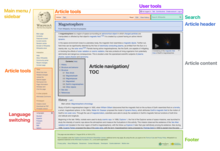阅读/网页/桌面版改进
|
桌面版改进
Vector皮肤的一系列新功能和重新编排
|
上一个维基媒体的默认皮肤(Vector)是在2010年推出的。 在隨後的十年中,扩展、小工具及用户脚本更是豐富了介面。 其中大部分並未进行過视觉或维基之間的协调。 與此同時,網站設計、以及讀者們、編者們的期待也逐漸進化了。 最後,我們決定将其中的一些想法以有组织、一致的方式带到所有维基的、所有用户的默认体验中了。
在2019年至2023年期间,我们正在打造一款新皮肤。 我们要讓维基媒体的维基更受欢迎,并增加对读者之間的实用性,和维护对现有编辑者的实用性。我们正在衡量对我们网站的信任度和好感度的增加情况,以及我们网站的实用性(搜索和语言切换等常用操作的使用情况)。
2022年,新皮肤成为默认皮肤。 从那时起,我们在越来越多的维基中推出这一功能。 最终,我们需要有一种皮肤作为所有地方的默认皮肤。 这是因为不可能无限期地将“2個”作为默认值。
更新
我们的目标是什么?
想像一個書櫃
-
我们已经逐步重新安排了这...
-
…变成这样😊
之前,界面…
…与期望不符。 …混乱而又不直观。 …不强调社群方面。 …与移动端不一致。

- 桌面界面与现代网络平台的期望不符。感觉迷失了方向,脱节了。导航和界面链接随意地组织着。
- Readers were unable to understand the purpose, terminology, and concepts of available tools such as the main menu, user menu, and page tools.
- Editors found the hierarchy of the navigation to be confusing for newcomers.
- Editors and other contributors wanted easier access to tools they used frequently.
- Editors expressed interest in having fewer, but more prominent, ways to begin contributing.
- 混乱的网页使用户无法专注于他们查找的内容。对于读者而言,专注看内容具有挑战性。新编辑者无法凭直觉完成與閱讀無關的簡單任務。
- Too much information density and navigational elements on the page made it difficult to focus on a particular reading or editing task.
- Readers found it difficult to navigate the page and spent a lot of time scrolling.
- Readers found it difficult to search for information that is relevant to them.
- Multilingual readers were not aware of language switching functionality.
- Readers wanted to have an easy way to view the table of contents throughout the page.
- Character count per line was more than three times the recommended value.
- 只有极少数的读者了解维基媒体计划的功能。许多读者并不知道他们正在阅读的内容是由志愿者编写并经常更新的,也不知道他们也能做出贡献。
- 我们的桌面版网站,移动版网站和应用程序之间的体验差异很大,这使读者很难连接我们的产品。 维基媒体的网站概念缺乏统一性。
更改将如何进行
原则
我们並沒有影响到内容。 除了Vector之外,我们不会修改其它皮肤。 我们不曾移除任何功能。 我们不曾一蹴而就地进行重大更改。
- 我们只在界面上下功夫。在样式模板、页面内容结构、映射支持或跨维基模板方面不曾有過任何更改。
- Vector以外的皮肤並不在我们的计划范围内。我们已经将Vector冻结为旧版Vector,并开始将我们的功能作为新的默认Vector的一部份部署。
- 我们在界面元素之间进行了移动,但是所有之前的导航项和其他默认可用的功能将保持不变。
- 我们采取了一种循序渐进的方法。我们希望試行维基能让读者和编辑继续感到熟悉。每个功能都是单独讨论、开发和部署的。
Process for developing the features
- 2019: Problem identification research with both readers and editors – We studied the way people used the site. We identified the largest usability issues as well as obstacles in becoming more engaged with reading or editing. We did this by interviewing readers and editors across multiple countries and locations. We also surveyed gadgets and user scripts. Some of them deserved to be surfaced and be a part of default experience. (See the links: Research and design: Phase 1, Research and design: Phase 2.)
- 2019–2022: Prototype development and testing – We built out the ideas for features and began showing prototypes. Each feature was tested with readers and editors through interviews and on-wiki prototype testing. We used Central Notice banners across multiple languages and Wikimedia projects. Each prototype was tested by approximately 200 editors on average. (Example)
- 2020–2023: Refining and building – We refined or changed the features based on the outcomes of the prototype testing. In some cases, we asked for additional opinions to ensure we were making the right decisions.
- 2020–2023: A/B testing and other quantitative testing on wikis – This was the "beta" phase:
- We performed tests for whether the features worked as expected based on the previously defined criteria of success. We made "before and after" comparisons or performed A/B tests. As the latter, we gave a new feature to 50% of users and compared them to the other 50%. After two weeks we compared the results.
- If we received negative results, we identified the reasons across different audiences and made changes to the feature. Then, we would test the feature again. In the case of significantly negative results, we rolled back our changes. (Example)
- 我们已与各种自愿参与的“早期采用者”(試行)维基合作测试這些變更,包括维基百科和姊妹项目。
- We also monitor usage across all wikis, where many account holders have been already using the new skin.
- 2022 – onwards: Deployments on more and more wikis – The results of testing and subsequent analysis concluded that our changes result in improved usage of the skin, and save time previously spent in scrolling, searching, and navigating. We interpret this as an easier and more comfortable reading experience. There are no negative effects to pageviews, account creation, or edit rates. Knowing this, we continue to roll out the skin on more and more wikis.
添加了哪些功能
部署计划和时间表
现在,该皮肤已准备就绪,可以成为任何wiki站点的默认皮肤。
| 越来越少的wiki | 越来越多的wiki |
|---|---|
| 编者和读者 默认不显示我们的变更 |
编者和读者 默认显示我们的变更 |
| 仅编者可以加入 (在用户设置中,通过选中外观标签中的Vector(2022)) |
仅编者可以退出 (使用侧边栏中的切换到旧外观,或直接在用户的参数设置内) |
| 年 | 月 | 部署 |
|---|---|---|
| 2019年 | 5月 | 第一次小组讨论 |
| 2020年 | 7月/8月 | 對第一批「優先採用者」(試行)維基(包括法語維基百科)推出了新標誌、可折疊側邊欄和限制內容寬度 |
| 9月 | 推出了新的搜尋小部件 | |
| 2021年 | 6月 | 推出了新的語言切換 |
| 2月 | 在更多試行维基上部署,包括孟加拉语、韩语和葡萄牙语维基 | |
| 2022年 | 8月 | 推出了新的使用者選單 |
| 1月 | 推出了新的黏性標頭 在更多試行维基上部署,包括印尼语、泰语和越南语维基 | |
| 2月 | 这些改动从Vector传统代码中分离出来,成为一个新的皮肤“Vector 2022”。 | |
| 5月 | 推出了新的目次 | |
| 6月 | 该皮肤已在最后一批試行维基上推出,包括加泰罗尼亚语和日语维基 推出了第一個視覺微調 | |
| 10月 | 部署在最小的维基百科上 | |
| 11月 | 推出了新的全宽/限宽切换按钮 | |
| 12月 | 部署在阿拉伯语和希腊语维基百科上 | |
| 2023年 | 1月 | 部署在英语维基百科上 |
| 2月 | 对于已注销的用户,全宽/限宽首选项将成为永久选项 | |
| 3月 | The new page tools menu is introduced | |
| 4月 | 部署在波兰维基百科上 | |
| 5月 | 部署在西班牙维基百科上 | |
| 8月 | 部署在中文(zh)和數个小型维基百科上 | |
| 10月 | 部署在瑞典语、匈牙利语、荷兰语、印地语和挪威语 bokmål 维基百科上 也可在元维基和大多数维基教科书、维基新闻、维基語錄和维基學院的维基上使用 | |
| 11月 | 部署在大多数的维基導遊和维基词典上 推出了最后一次视觉改进(称为斑马9) | |
| 2024年 | 3月 | 部署在大多数维基资源和基金会内部的维基上 |
联系
- 选择个人加入:在首选项中,检查选项“Vector(2022)”。 您还可以使用全域设置启用我们的更改。
- 推广:通知您的社区。分享我们的最新和博客文章。
- 回报错误:要回报错误,请在Phabricator上创建一个任务(task)并添加#Desktop Improvements Vector 2022项目。
- 翻译:帮助我们翻译相关页面:
优先翻译
|
|---|
|
排行前三 其他的优先翻译 |






